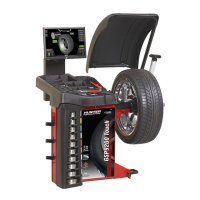14 INTRODUCTION TO BALANCING
2.4 Using SmartWeight Balancing
Technology®
The SmartWeight® balancing forces display
varies greatly from the standard balancing display.
SmartWeight® tire graphs independently display the
static and couple forces within a tire/wheel assembly.
A single plane (static) mode and non-round off modes
are no longer necessary. The traditional “static” and
“dynamic” modes are eliminated. The traditional non-
round off mode is eliminated. These modes are no longer
necessary with SmartWeight® balancing.
COUPLE
FORCE
LIMIT
FORCE
DISPLAY
RESIDUAL
COUPLE
FORCE
FORCE
DISPLAY
STATIC
FORCE
LIMIT
RESIDUAL
STATIC
FORCE
Figure 28.
The red-dotted line represents the acceptable amount of
force the tire and wheel assembly can have that will not
result in a ride problem. Any forces below that line will
be shown in green. Any forces that are above that level
will be shown in red and indicate an excessive amount of
force.
Install a tire/wheel assembly as normal. Rim
measurements are not required to determine if the
balance forces are exceeded. Lower the hood and spin.
Figure 29.
2.3 SmartWeight Balancing
Technology® Dynamic Weight Planes
SmartWeight® requires the operator to enter at least two
weight planes. This balancing method will automatically
determine if one or both weight planes require a weight
to be added. This eliminates “blinded” static single plane
balancing, which alone may not be sufficient to solve
couple vibration issues.
The SmartWeight Touch®/GSP9200 Touch balancer
offers two primary ways to balance tires:
1. SmartWeight Balancing Technology®
Figure 26.
2. Traditional balancing technology.
Figure 27.
Both of these methods can balance tires dynamically.
The main difference being that SmartWeight® will
reduce the amount of corrective weight in a basic wheel
balancing situation and automatically optimize static force
reduction and single plane weight placement.

